Multi-Scale Channel Mixing Convolutional Network and Enhanced Residual Shrinkage Network for Rolling Bearing Fault Diagnosis
Abstract
1. Introduction
- (1)
- We propose a multi-scale channel mixing convolutional network (MSCMN) to extract the presence of multi-timescale features of vibration signals of mechanical equipment through multi-scale coarse-grained convolutional layers. Unlike existing studies that focus only on the relationship between channel features, the MSCMN is capable of mixing different channel features and learning adaptive weights, thus suppressing the noise information in the vibration signals and enhancing the correlation and learnability between the features.
- (2)
- We also propose an enhanced deep residual shrinkage network (eDRSN) that replaces the traditional linear layer with a new KANLinear layer. By fitting data distributions more accurately, KANLinear improves the learning capacity of the attention module of the DRSN, resulting in more precise threshold outputs and further enhancing the denoising capability of the network.
- (3)
- We present a novel approach based on a multi-scale channel mixing convolutional network and an enhanced residual shrinkage network (MSCMN-eDRSN) for bearing fault diagnosis. To evaluate the effectiveness and advantages of our proposed method, we performed comprehensive experiments using both the Case Western Reserve University (CWRU) bearing dataset and our own laboratory bearing dataset. Our method was benchmarked against leading algorithms in the field, highlighting its performance and robustness across various scenarios.
2. Network Structure and Theoretical Foundations
2.1. Convolutional Neural Networks
2.2. Multi-Scale Channel Mixing Convolutional Network (MSCMN)
2.3. Kolmogorov–Arnold Networks
2.4. Kolmogorov–Arnold Networks–Linear (KANLinear)
2.5. Enhanced DRSN
3. Fault Diagnosis Based on MSCMN-eDRSN
- Step 1: The original time-domain vibration signal is acquired;
- Step 2: The data are intercepted, and the training set and test set are divided according to a certain ratio;
- Step 3: The training set is fed into the MSCMN-eDRSN model in batches until the error converges;
- Step 4: The model is evaluated on the test set, and the corresponding results are recorded.
4. Analysis and Discussion of Experiments Results
4.1. Experimental Environment and Parameter Settings
4.2. Case1: CWRU Bearing Dataset
4.2.1. Dataset Description
4.2.2. Comparative Tests
4.2.3. Ablation Experiments
4.3. Case 2: Laboratory Bearing Dataset
4.3.1. Introduction to Datasets
4.3.2. Comparative Tests
5. Conclusions
Author Contributions
Funding
Data Availability Statement
Conflicts of Interest
References
- Chen, X.; Yang, R.; Xue, Y.; Huang, M.; Ferrero, R.; Wang, Z. Deep transfer learning for bearing fault diagnosis: A systematic review since 2016. IEEE Trans. Instrum. Meas. 2023, 72, 3508221. [Google Scholar] [CrossRef]
- Rai, A.; Upadhyay, S.H. A review on signal processing techniques utilized in the fault diagnosis of rolling element bearings. Tribol. Int. 2016, 103, 289–306. [Google Scholar] [CrossRef]
- Ju, Y.; Tian, X.; Liu, H.; Ma, L. Fault detection of networked dynamical systems: A survey of trends and techniques. Int. J. Syst. Sci. 2021, 52, 3390–3409. [Google Scholar] [CrossRef]
- Chen, Z.; Li, W. Multisensor feature fusion for bearing fault diagnosis using sparse autoencoder and deep belief network. IEEE Trans. Instrum. Meas. 2017, 66, 1693–1702. [Google Scholar] [CrossRef]
- Tse, P.W.; Peng, Y.H.; Yam, R. Wavelet analysis and envelope detection for rolling element bearing fault diagnosis—Their effectiveness and flexibilities. J. Vib. Acoust. 2001, 123, 303–310. [Google Scholar] [CrossRef]
- Faysal, A.; Ngui, W.K.; Lim, M.H. Noise eliminated ensemble empirical mode decomposition for bearing fault diagnosis. J. Vib. Eng. Technol. 2021, 9, 2229–2245. [Google Scholar] [CrossRef]
- Liu, C.; Zhu, L.; Ni, C. Chatter detection in milling process based on VMD and energy entropy. Mech. Syst. Signal Process. 2018, 105, 169–182. [Google Scholar] [CrossRef]
- Kedadouche, M.; Thomas, M.; Tahan, A. A comparative study between empirical wavelet transforms and empirical mode decomposition methods: Application to bearing defect diagnosis. Mech. Syst. Signal Process. 2016, 88, 88–107. [Google Scholar] [CrossRef]
- Zhou, Z.; Wen, C.; Yang, C. Fault isolation based on k-nearest neighbor rule for industrial processes. IEEE Trans. Ind. Electron. 2016, 63, 2578–2586. [Google Scholar] [CrossRef]
- Li, P.; Liu, Z.; Anduv, B.; Zhu, X.; Jin, X.; Du, Z. Diagnosis for multiple faults of chiller using ELM-KNN model enhanced by multi-label learning and specific feature combinations. Build. Environ. 2022, 214, 108904. [Google Scholar] [CrossRef]
- Gao, L.; Li, D.; Yao, L.; Gao, Y. Sensor drift fault diagnosis for chiller system using deep recurrent canonical correlation analysis and k-nearest neighbor classifier. ISA Trans. 2022, 122, 232–246. [Google Scholar] [CrossRef] [PubMed]
- Yin, Z.; Hou, J. Recent advances on SVM based fault diagnosis and process monitoring in complicated industrial processes. Neurocomputing 2016, 174, 643–650. [Google Scholar] [CrossRef]
- Sun, K.; Li, G.; Chen, H.; Liu, J.; Li, J.; Hu, W. A novel efficient SVM-based fault diagnosis method for multi-split air conditioning system’s refrigerant charge fault amount. Appl. Therm. Eng. 2016, 108, 989–998. [Google Scholar] [CrossRef]
- Shi, Q.; Zhang, H. Fault diagnosis of an autonomous vehicle with an improved SVM algorithm subject to unbalanced datasets. IEEE Trans. Ind. Electron. 2020, 68, 6248–6256. [Google Scholar] [CrossRef]
- Cerrada, M.; Zurita, G.; Cabrera, D.; Sánchez, R.V.; Artés, M.; Li, C. Fault diagnosis in spur gears based on genetic algorithm and random forest. Mech. Syst. Signal Process. 2016, 70, 87–103. [Google Scholar] [CrossRef]
- Cao, Y.; Ji, Y.; Sun, Y.; Su, S. The fault diagnosis of a switch machine based on deep random forest fusion. IEEE Intell. Transp. Syst. Mag. 2022, 15, 437–452. [Google Scholar] [CrossRef]
- Hosseinpour-Zarnaq, M.; Omid, M.; Biabani-Aghdam, E. Fault diagnosis of tractor auxiliary gearbox using vibration analysis and random forest classifier. Inf. Process. Agric. 2022, 9, 60–67. [Google Scholar] [CrossRef]
- Moosavi, F.; Shiri, H.; Vashishtha, G.; Chauhan, S.; Wylomanska, A.; Zimroz, R. Novelty detection for long-term diagnostic data with Gaussian and non-Gaussian disturbances using a support vector machine. Meas. Sci. Technol. 2024, 36, 016195. [Google Scholar] [CrossRef]
- Liu, X.; Lu, J.; Li, Z. Multi-scale fusion attention convolutional neural network for fault diagnosis of aero-engine rolling bearing. IEEE Sens. J. 2023, 23, 12955–12964. [Google Scholar]
- Elsisi, M.; Tran, M.Q.; Mahmoud, K.; Mansour, D.E.A.; Lehtonen, M.; Darwish, M.M. Effective IoT-based deep learning platform for online fault diagnosis of power transformers against cyberattacks and data uncertainties. Measurement 2022, 190, 110686. [Google Scholar] [CrossRef]
- Zhao, B.; Zhang, X.; Wu, Q.; Yang, Z.; Zhan, Z. A novel unsupervised directed hierarchical graph network with clustering representation for intelligent fault diagnosis of machines. Mech. Syst. Signal Process. 2023, 183, 109615. [Google Scholar] [CrossRef]
- Shao, H.; Jiang, H.; Zhang, X.; Niu, M. Rolling bearing fault diagnosis using an optimization deep belief network. Meas. Sci. Technol. 2015, 26, 115002. [Google Scholar] [CrossRef]
- Xing, S.; Lei, Y.; Wang, S.; Jia, F. Distribution-invariant deep belief network for intelligent fault diagnosis of machines under new working conditions. IEEE Trans. Ind. Electron. 2020, 68, 2617–2625. [Google Scholar] [CrossRef]
- Wen, L.; Gao, L.; Li, X. A new deep transfer learning based on sparse auto-encoder for fault diagnosis. IEEE Trans. Syst. Man Cybern. Syst. 2017, 49, 136–144. [Google Scholar] [CrossRef]
- Li, X.; Jia, X.D.; Zhang, W.; Ma, H.; Luo, Z.; Li, X. Intelligent cross-machine fault diagnosis approach with deep auto-encoder and domain adaptation. Neurocomputing 2020, 383, 235–247. [Google Scholar] [CrossRef]
- Eren, L.; Ince, T.; Kiranyaz, S. A generic intelligent bearing fault diagnosis system using compact adaptive 1D CNN classifier. J. Signal Process. Syst. 2019, 91, 179–189. [Google Scholar] [CrossRef]
- Wen, L.; Li, X.; Gao, L.; Zhang, Y. A new convolutional neural network-based data-driven fault diagnosis method. IEEE Trans. Ind. Electron. 2017, 65, 5990–5998. [Google Scholar] [CrossRef]
- Wang, S.; Shuai, H.; Hu, J.; Zhang, J.; Liu, S.; Yuan, X.; Liang, P. Few-shot fault diagnosis of axial piston pump based on prior knowledge-embedded meta learning vision transformer under variable operating conditions. Expert Syst. Appl. 2025, 269, 126452. [Google Scholar] [CrossRef]
- Huang, T.; Zhang, Q.; Tang, X.; Zhao, S.; Lu, X. A novel fault diagnosis method based on CNN and LSTM and its application in fault diagnosis for complex systems. Artif. Intell. Rev. 2022, 55, 1289–1315. [Google Scholar] [CrossRef]
- Wang, H.; Liu, Z.; Peng, D.; Yang, M.; Qin, Y. Feature-level attention-guided multitask CNN for fault diagnosis and working conditions identification of rolling bearing. IEEE Trans. Neural Netw. Learn. Syst. 2021, 33, 4757–4769. [Google Scholar] [CrossRef]
- He, K.; Zhang, X.; Ren, S.; Sun, J. Deep residual learning for image recognition. In Proceedings of the IEEE Conference on Computer Vision and Pattern Recognition, Seattle, WA, USA, 27–30 June 2016; pp. 770–778. [Google Scholar]
- Zhao, M.; Zhong, S.; Fu, X.; Tang, B.; Pecht, M. Deep residual shrinkage networks for fault diagnosis. IEEE Trans. Ind. Inform. 2020, 16, 4681–4690. [Google Scholar] [CrossRef]
- Li, X.; Chen, J.; Wang, J.; Wang, J.; Li, X.; Kan, Y. Research on fault diagnosis method of bearings in the spindle system for CNC machine tools based on DRSN-Transformer. IEEE Access 2024, 12, 74586–74595. [Google Scholar] [CrossRef]
- Zhang, Z.; Chen, L.; Zhang, C.; Shi, H.; Li, H. GMA-DRSNs: A novel fault diagnosis method with global multi-attention deep residual shrinkage networks. Measurement 2022, 196, 196. [Google Scholar] [CrossRef]
- Zhang, Z.; Zhang, C.; Chen, L.; Li, H.; Han, P. LGMA-DRSN: A lightweight convex global multi-attention deep residual shrinkage network for fault diagnosis. Meas. Sci. Technol. 2023, 34, 115011. [Google Scholar] [CrossRef]
- Zhang, L.; Xiong, G.; Liu, H.; Zou, H.; Guo, W. Bearing fault diagnosis using multi-scale entropy and adaptive neuro-fuzzy inference. Expert Syst. Appl. 2010, 37, 6077–6085. [Google Scholar] [CrossRef]
- Jiang, G.; He, H.; Yan, J.; Xie, P. Multiscale convolutional neural networks for fault diagnosis of wind turbine gearbox. IEEE Trans. Ind. Electron. 2018, 66, 3196–3207. [Google Scholar] [CrossRef]
- Wu, X.; Shi, H.; Zhu, H. Fault diagnosis for rolling bearings based on multiscale feature fusion deep residual networks. Electronics 2023, 12, 768. [Google Scholar] [CrossRef]
- Shang, Z.; Li, W.; Gao, M.; Liu, X.; Yu, Y. An intelligent fault diagnosis method of multi-scale deep feature fusion based on information entropy. Chin. J. Mech. Eng. 2021, 34, 58. [Google Scholar] [CrossRef]
- LeCun, Y.; Bengio, Y.; Hinton, G. Deep learning. Nature 2015, 521, 436–444. [Google Scholar] [CrossRef]
- Zhang, P.; Wang, D.; Lu, H.; Wang, H.; Ruan, X. AMULET: Aggregating multi-level convolutional features for salient object detection. In Proceedings of the IEEE International Conference on Computer Vision, Venice, Italy, 22–29 October 2017; pp. 202–211. [Google Scholar]
- Liu, Z.; Wang, Y.; Vaidya, S.; Ruehle, F.; Halverson, J.; Soljačić, M.; Hou, T.Y.; Tegmark, M. KAN: Kolmogorov-Arnold Networks. arXiv 2024, arXiv:2404.19756. [Google Scholar]
- Kolmogorov, A.N. On the representation of continuous functions of several variables by superpositions of continuous functions of a smaller number of variables. Am. Math. Soc. 1961. [Google Scholar] [CrossRef]
- Kolmogorov, A.N. On the representation of continuous functions of many variables by superposition of continuous functions of one variable and addition. Dokl. Akad. Nauk 1957, 114, 953–956. [Google Scholar]
- Braun, J.; Griebel, M. On a constructive proof of Kolmogorov’s superposition theorem. Constr. Approx. 2009, 30, 653–675. [Google Scholar] [CrossRef]
- Hu, J.; Shen, L.; Sun, G. Squeeze-and-excitation networks. In Proceedings of the IEEE Conference on Computer Vision and Pattern Recognition, Salt Lake City, UT, USA, 18–23 June 2018. [Google Scholar]

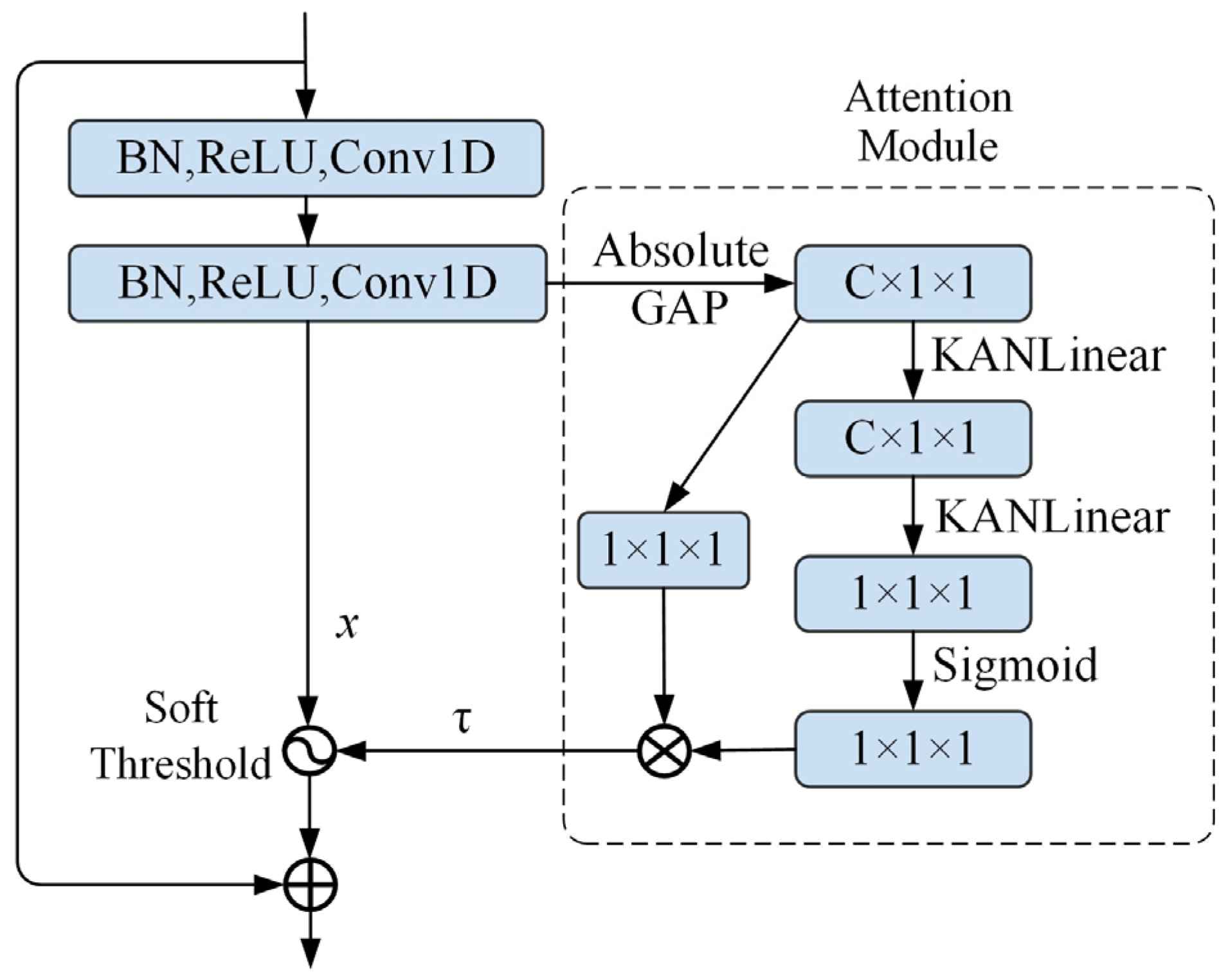
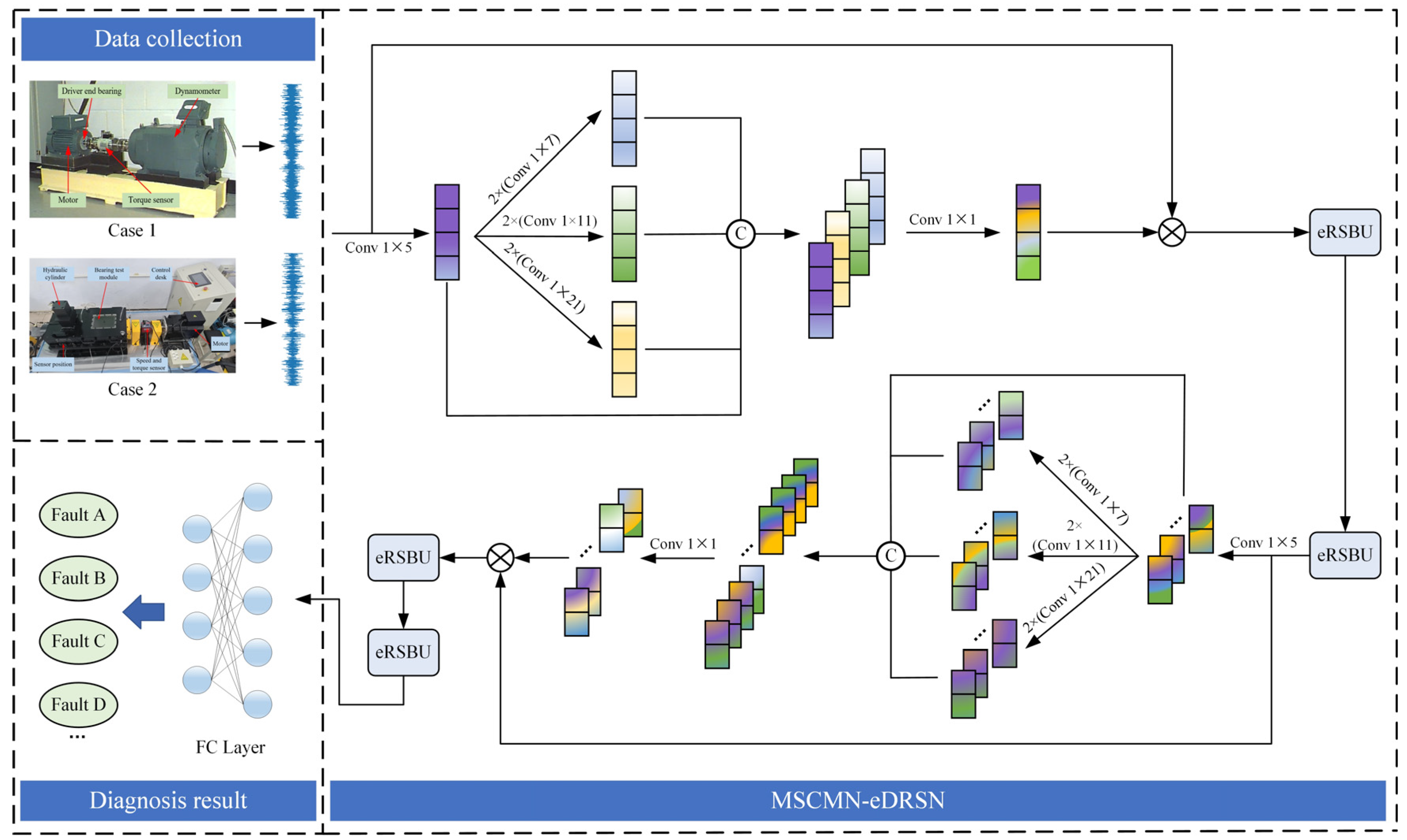


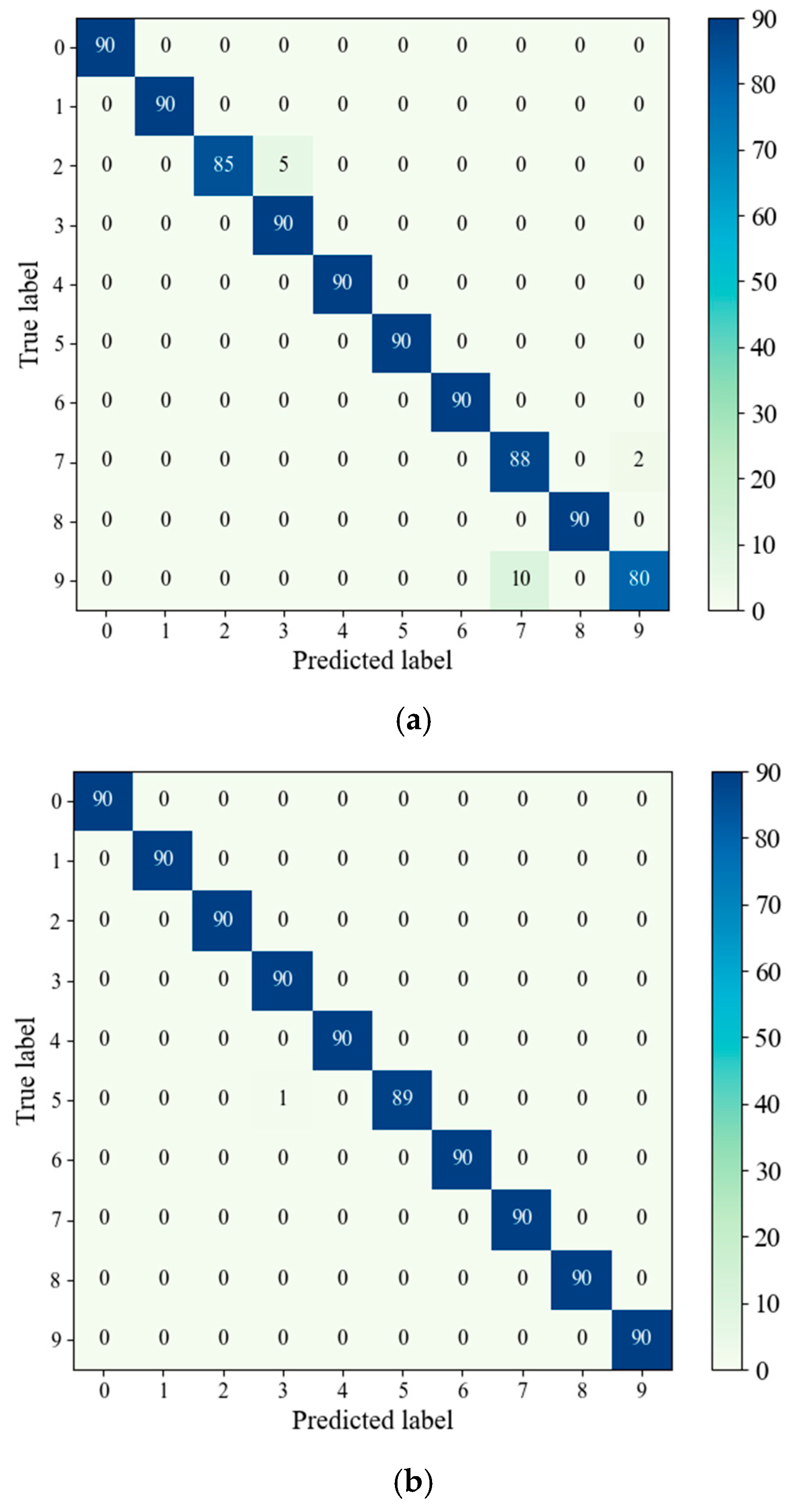
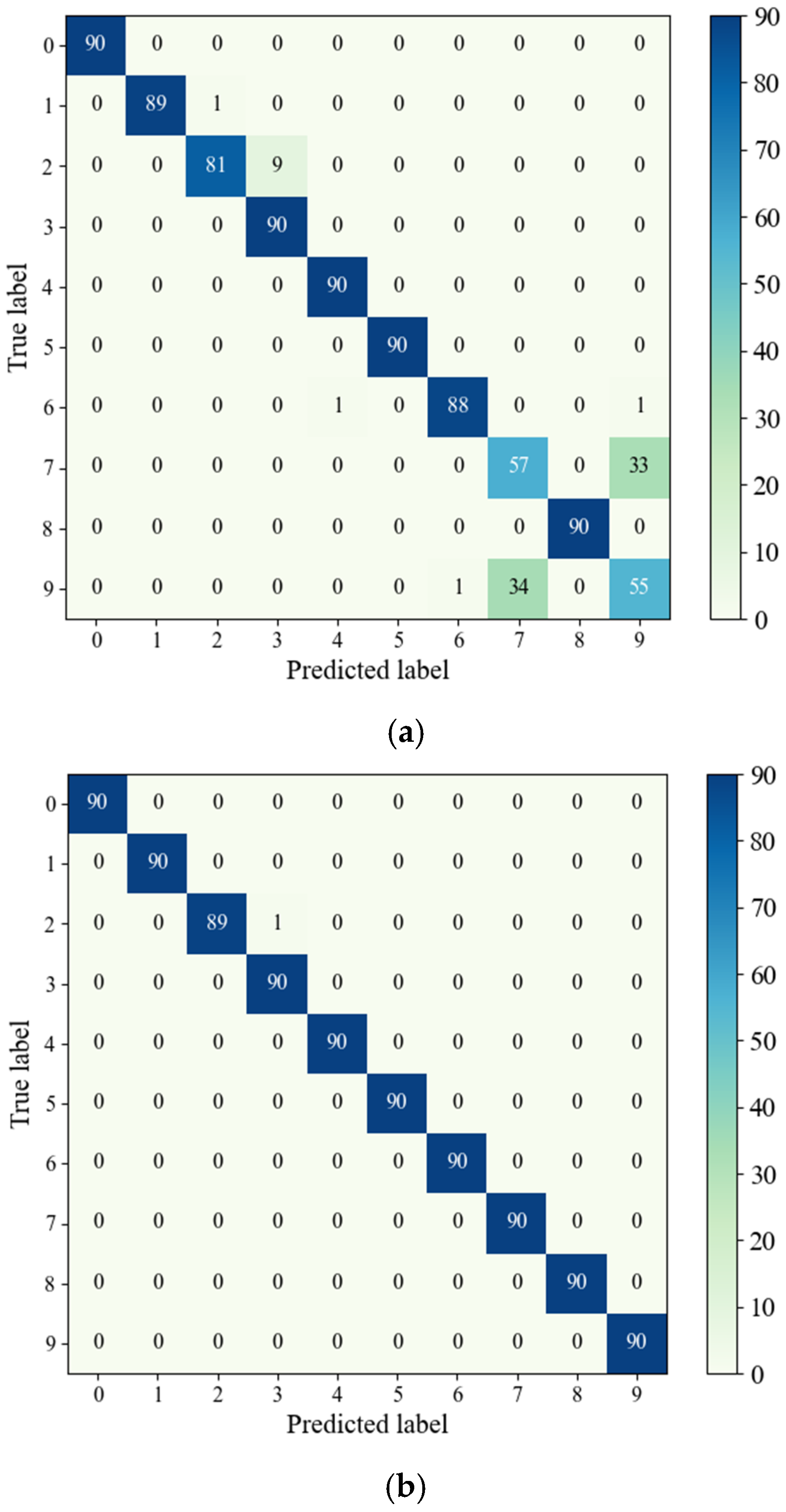

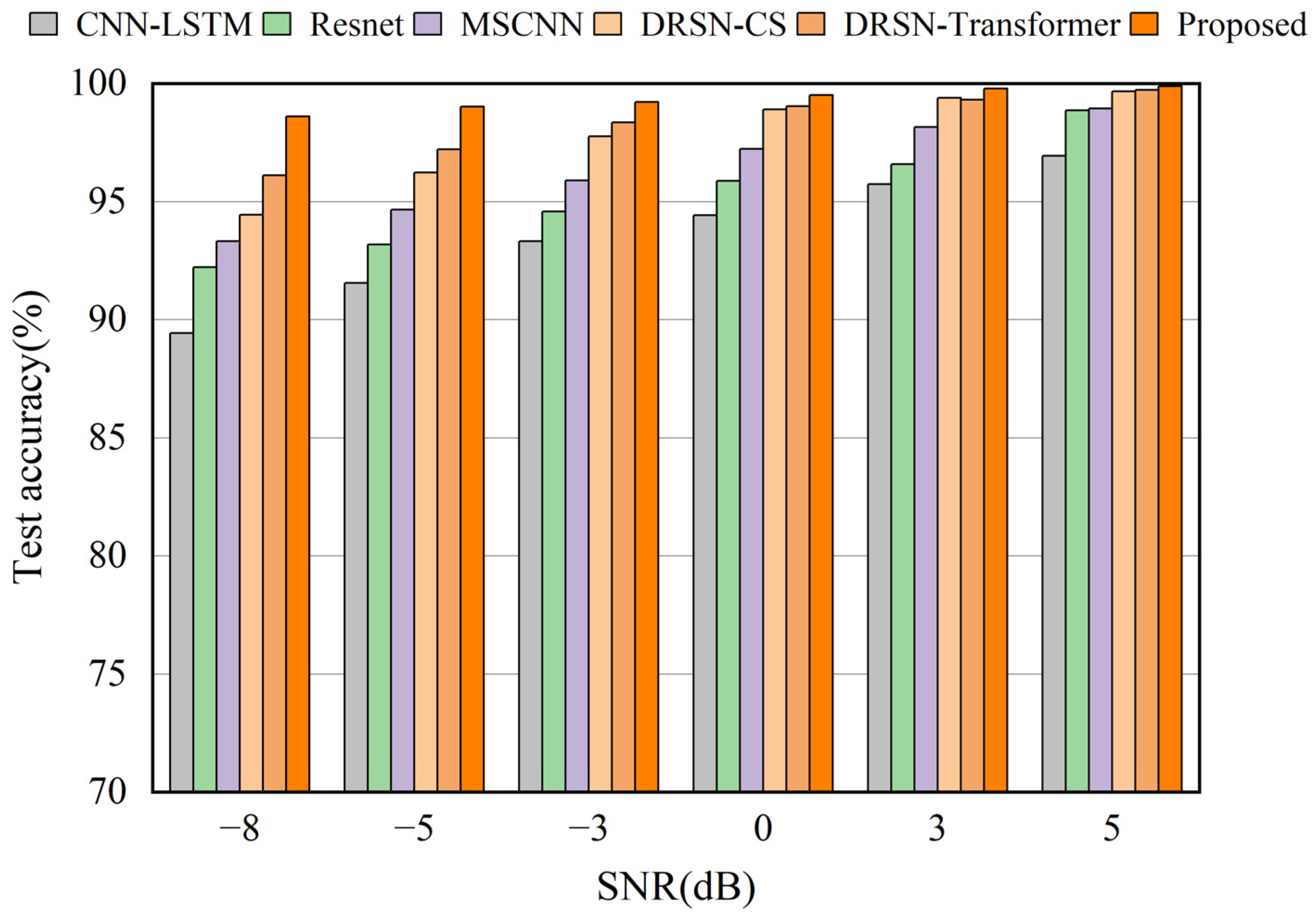

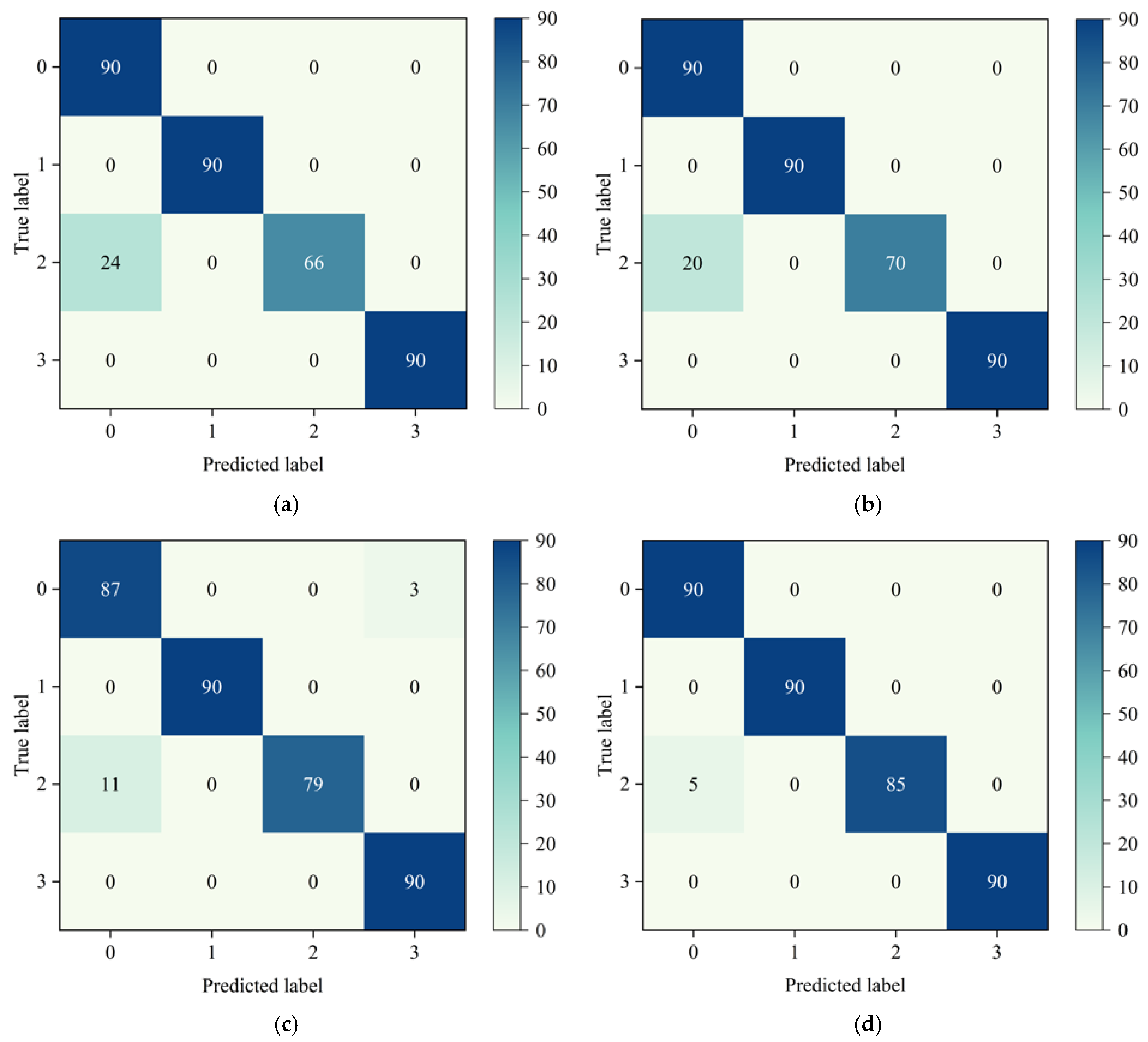
| Number of Components | Output Size | Modules |
|---|---|---|
| 1 | 1 × 2048 × 1 | MSCMN |
| 2 | 16 × 1024 × 1 | eRSBU |
| 1 | 32 × 512 × 1 | MSCMN |
| 2 | 64 × 128 × 1 | eRSBU |
| 1 | 256 | FC |
| 1 | 10 or 4 | FC |
| Fault Description | Fault Diameter (mm) | Training Samples | Test Samples | Label |
|---|---|---|---|---|
| Normal | 0 | 210 | 90 | 0 |
| Ball defect | 0.1778 | 210 | 90 | 1 |
| Ball defect | 0.3556 | 210 | 90 | 2 |
| Ball defect | 0.5334 | 210 | 90 | 3 |
| Inner race defect | 0.1778 | 210 | 90 | 4 |
| Inner race defect | 0.3556 | 210 | 90 | 5 |
| Inner race defect | 0.5334 | 210 | 90 | 6 |
| Outer race defect | 0.1778 | 210 | 90 | 7 |
| Outer race defect | 0.3556 | 210 | 90 | 8 |
| Outer race defect | 0.5334 | 210 | 90 | 9 |
| Method | Test Time (S) | Total Parameters |
|---|---|---|
| CNN-LSTM | 1.314 | 9.76 × 106 |
| MSCNN | 1.299 | 2.17 × 106 |
| DRSN–Transformer | 1.212 | 6.46 × 105 |
| Resnet | 1.152 | 2.54 × 106 |
| MSCMN-eDRSN (proposed) | 1.137 | 2.27 × 106 |
| DRSN-CS | 1.011 | 3.10 × 105 |
| Only KANLinear | Only MSCMN | Neither | Both | |
|---|---|---|---|---|
| Gaussian | 95.67 | 96.21 | 93.55 | 98.11 |
| Laplace | 88.21 | 89.94 | 87.78 | 91.11 |
| Training time | 252.25 | 245.89 | 237.21 | 252.79 |
| Fault Type | Training Numbers | Test Numbers | Label |
|---|---|---|---|
| NF | 210 | 90 | 0 |
| IF | 210 | 90 | 1 |
| BF | 210 | 90 | 2 |
| OF | 210 | 90 | 3 |
| Model | SNR (dB) | |||||
|---|---|---|---|---|---|---|
| −8 | −5 | −3 | 0 | 3 | 5 | |
| CNN-LSTM | 89.44 | 91.56 | 93.33 | 94.42 | 95.74 | 96.94 |
| Resnet | 92.22 | 93.19 | 94.58 | 95.87 | 96.59 | 98.86 |
| MSCNN | 93.33 | 94.65 | 95.89 | 97.23 | 98.16 | 98.94 |
| DRSN-CS | 94.44 | 96.23 | 97.76 | 98.89 | 99.39 | 99.67 |
| DRSN–Transformer | 96.11 | 97.21 | 98.34 | 99.04 | 99.32 | 99.73 |
| Proposed | 98.61 | 99.01 | 99.21 | 99.51 | 99.78 | 99.89 |
| Model | SNR (dB) | |||||
|---|---|---|---|---|---|---|
| −8 | −5 | −3 | 0 | 3 | 5 | |
| CNN-LSTM | 85.00 | 87.43 | 89.55 | 92.65 | 94.62 | 96.11 |
| Resnet | 89.44 | 91.64 | 92.85 | 94.69 | 96.38 | 97.25 |
| MSCNN | 91.94 | 93.41 | 94.72 | 95.81 | 96.95 | 97.75 |
| DRSN-CS | 92.22 | 94.34 | 95.44 | 96.63 | 97.59 | 98.56 |
| DRSN–Transformer | 94.44 | 95.56 | 96.88 | 98.00 | 98.92 | 99.21 |
| Proposed | 96.11 | 96.79 | 97.65 | 98.56 | 99.42 | 99.67 |
Disclaimer/Publisher’s Note: The statements, opinions and data contained in all publications are solely those of the individual author(s) and contributor(s) and not of MDPI and/or the editor(s). MDPI and/or the editor(s) disclaim responsibility for any injury to people or property resulting from any ideas, methods, instructions or products referred to in the content. |
© 2025 by the authors. Licensee MDPI, Basel, Switzerland. This article is an open access article distributed under the terms and conditions of the Creative Commons Attribution (CC BY) license (https://creativecommons.org/licenses/by/4.0/).
Share and Cite
Li, X.; Chen, J.; Wang, J.; Wang, J.; Wang, J.; Li, X.; Kan, Y. Multi-Scale Channel Mixing Convolutional Network and Enhanced Residual Shrinkage Network for Rolling Bearing Fault Diagnosis. Electronics 2025, 14, 855. https://doi.org/10.3390/electronics14050855
Li X, Chen J, Wang J, Wang J, Wang J, Li X, Kan Y. Multi-Scale Channel Mixing Convolutional Network and Enhanced Residual Shrinkage Network for Rolling Bearing Fault Diagnosis. Electronics. 2025; 14(5):855. https://doi.org/10.3390/electronics14050855
Chicago/Turabian StyleLi, Xiaoxu, Jiaming Chen, Jianqiang Wang, Jixuan Wang, Jiahao Wang, Xiaotao Li, and Yingnan Kan. 2025. "Multi-Scale Channel Mixing Convolutional Network and Enhanced Residual Shrinkage Network for Rolling Bearing Fault Diagnosis" Electronics 14, no. 5: 855. https://doi.org/10.3390/electronics14050855
APA StyleLi, X., Chen, J., Wang, J., Wang, J., Wang, J., Li, X., & Kan, Y. (2025). Multi-Scale Channel Mixing Convolutional Network and Enhanced Residual Shrinkage Network for Rolling Bearing Fault Diagnosis. Electronics, 14(5), 855. https://doi.org/10.3390/electronics14050855





